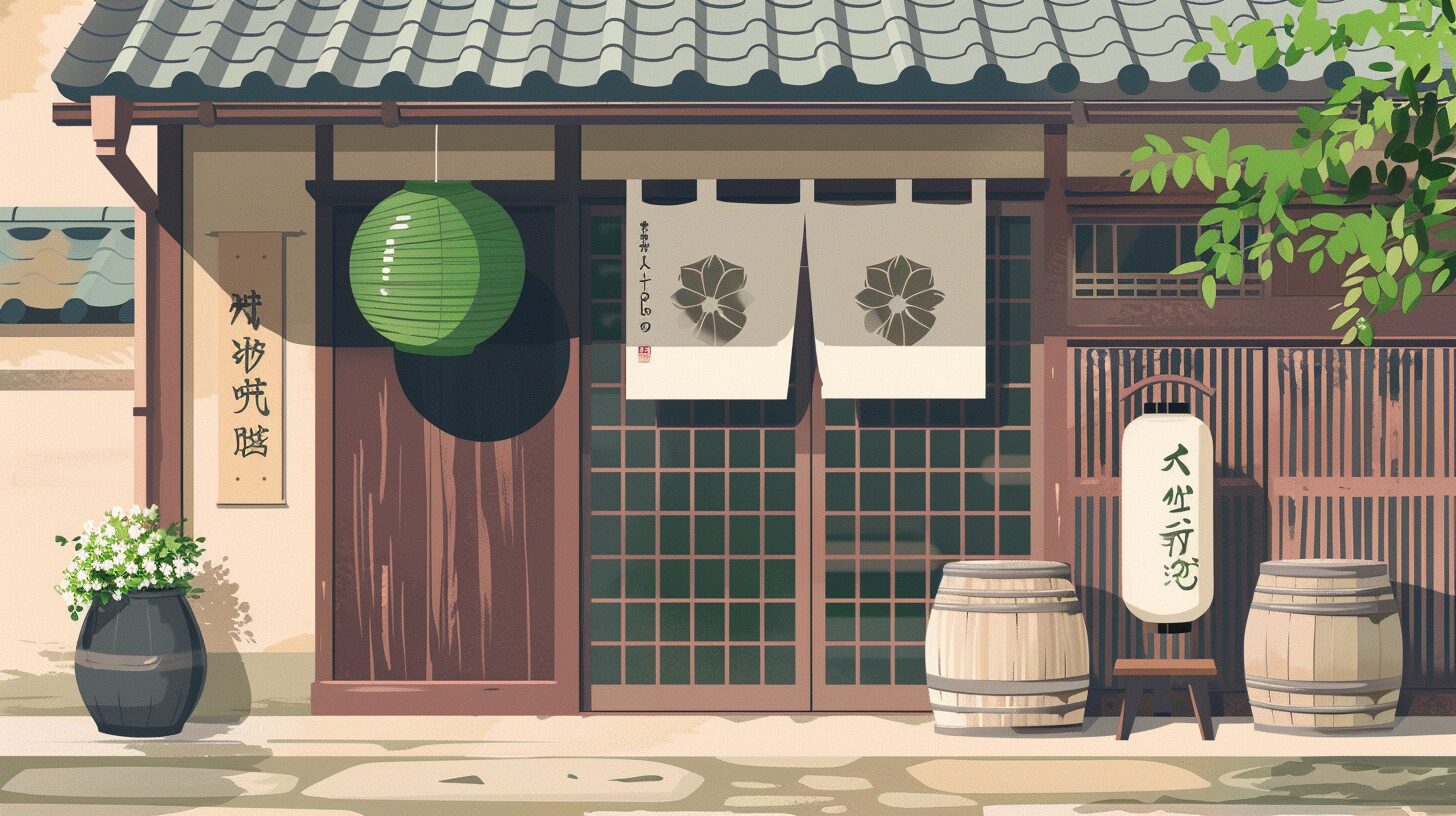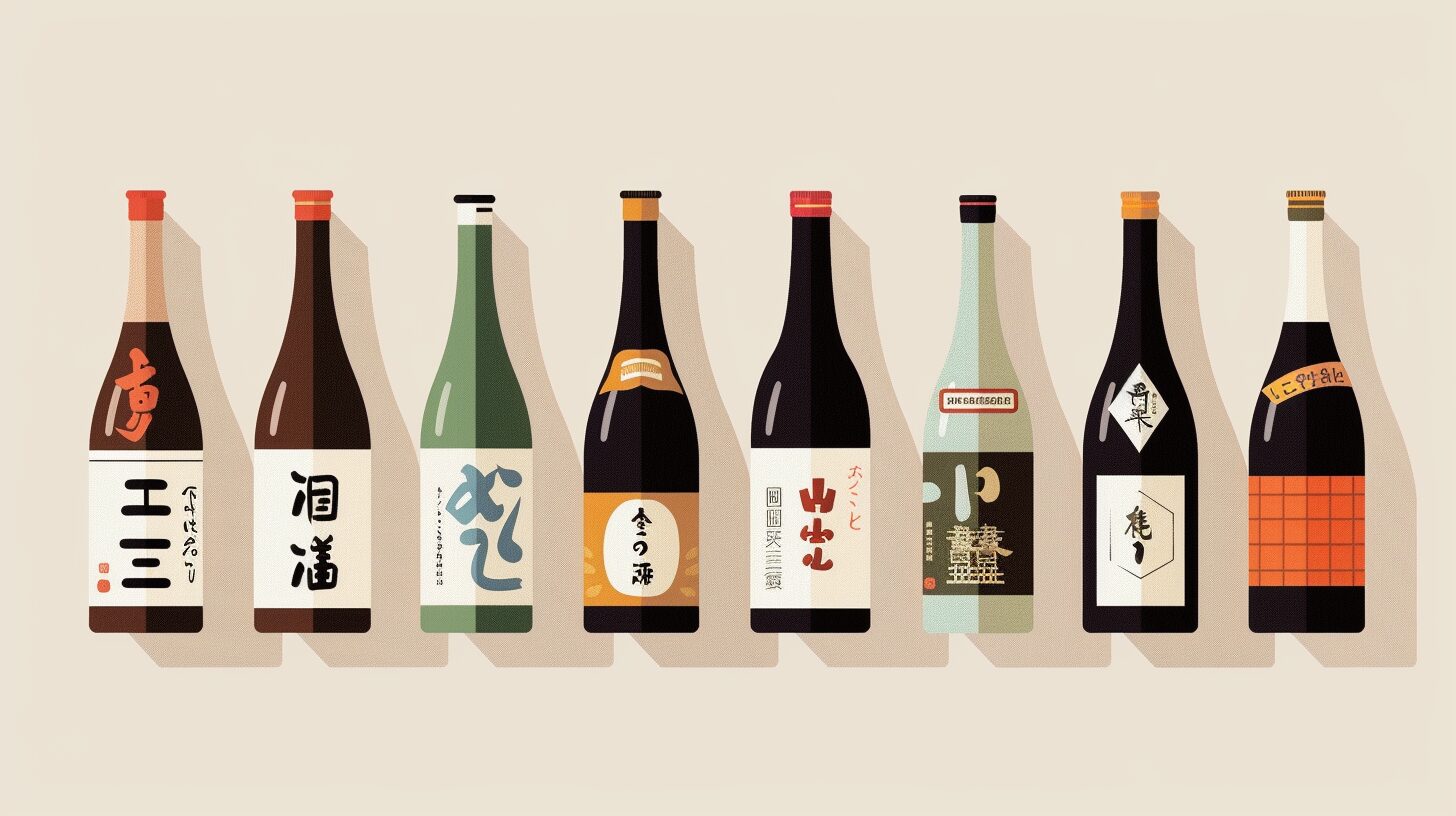日本酒を英語で説明・紹介するための基本情報と、英会話に役立つ表現をシンプルでわかりやすい英語で紹介します。
英会話ダイアローグ・関連情報・10の質問を通して、日本酒に関する英語表現を学びます。
英語
英会話ダイアローグを読む前に知っておくと良い前提知識と情報は以下の通りです。
1. 日本酒の基本情報
・日本酒は「にほんしゅ」や「さけ」とも呼ばれる日本の伝統的なアルコール飲料
・主な原料は米、米麹、水
2. 日本酒の種類
・純米酒: 米と米麹のみで作られた酒。強い米の風味
・吟醸酒: 米を60%以下まで磨いて作る酒。フルーティーな香りと繊細な味わいが特徴
・大吟醸酒: 米を50%以下まで磨いて作る高級酒。非常に香り高く滑らかな味
・本醸造酒: 米、米麹に少量のアルコールを加えて作られる酒。軽快な飲み口が特徴
3. 日本酒の製造過程
・米を磨き、洗浄して浸漬し、蒸す
・蒸した米を使って米麹を作る
・米麹と水を混ぜて酵母を作り、発酵させる
・発酵後、もろみを絞り、液体部分を取り出して熟成させる
4. 日本酒の飲み方
・日本酒は冷やして(冷酒)、常温で(常温酒)、温めて(燗酒)楽しめる
・温度によって味わいや香りが変わる
5. 日本の有名な酒造地域
・灘(兵庫県): 六甲山のミネラル豊富な水を使い、キレのある辛口の酒が特徴
・伏見(京都府): 良質な地下水を使い、まろやかで柔らかい味わい
・広島(広島県): 軟水を使い、繊細でフルーティーな味わいが特徴
6. 人気の日本酒銘柄
・獺祭(だっさい): フルーティーで飲みやすい
・八海山: すっきりとした味わいで食事に合う
2人が日本酒について話しています。
日本酒の種類、製造過程、温度による味わいの違い、有名な酒造地域や人気の銘柄などを話題にしています。
会話 / dialogue

Hey Key, I’ve recently developed an interest in sake. Have you ever tried it?

Yes, I have! Sake is quite fascinating. Did you know it’s also called “nihonshu” in Japan?

I did hear that. I bought a bottle of Junmai-shu the other day. It’s made only from rice and rice malt, right?

Exactly. Junmai-shu is pure and has a strong rice flavor. It’s a great choice for beginners. There are also other types like Ginjo-shu and Daiginjo-shu.

What’s the difference between them?

Ginjo-shu is made with rice polished to 60% of its original size. It has a fruity aroma and delicate taste. Daiginjo-shu is even more polished, down to 50%, making it very fragrant and smooth. It’s considered a high-quality sake.

That sounds interesting. I also learned about the sake-making process. It involves polishing, washing, steaming the rice, and then creating rice malt.

Yes, and then they create a yeast starter and ferment it. After fermentation, the mixture is pressed to separate the liquid sake from the solids. The sake is then stored and aged.

I see. I’ve heard that sake can be enjoyed at different temperatures. Is that true?

Absolutely. Sake can be enjoyed cold, at room temperature, or warm. The taste and aroma change with the temperature, so it’s fun to experiment.

That’s good to know. I recently visited a supermarket and saw a variety of sake. Are there specific regions in Japan known for their sake?

Yes, the three most famous regions are Nada in Hyogo Prefecture, Fushimi in Kyoto, and Hiroshima. Each has its own unique characteristics.

I bought a bottle from Nada. They use mineral-rich water from the Rokko mountains, which makes the sake clean and dry.

Great choice! Sake from Fushimi, on the other hand, uses soft water, making it smooth and mild. Hiroshima sake is known for its delicate and fruity taste.

That’s fascinating. I also heard about some popular brands like Dassai and Hakkaisan.

Yes, Dassai is known for its fruity and easy-to-drink taste, while Hakkaisan is clean and goes well with meals.

Thanks for all the info, Key. I feel more confident about exploring different kinds of sake now.

You’re welcome, Mack. Enjoy your sake journey!
関連情報 / related information
「日本酒」について、理解を深めるための「英語での関連情報」です。
日本酒

What is Sake?
Sake, also known as “nihonshu,” is a traditional Japanese alcoholic drink made from rice, rice malt, and water. It has been enjoyed in Japan for centuries and is an important part of Japanese culture.
Types of Sake
There are different types of sake. Junmai-shu is made only from rice and rice malt and has a strong rice flavor. Ginjo-shu is made with rice polished to 60% of its original size and has a fruity aroma. Daiginjo-shu is made with rice polished to 50% and is very fragrant and smooth. Honjozo-shu is made with rice, rice malt, and a small amount of added alcohol and is light and easy to drink.
How Sake is Made
Sake is made through several steps. First, the rice is polished, washed, soaked, and steamed. Then, the steamed rice is used to make rice malt. The rice malt and water are mixed to create yeast, which is then fermented. After fermentation, the mixture is pressed to separate the liquid sake from the solids, and the sake is aged.
How to Enjoy Sake
Sake can be enjoyed in different ways. You can drink it cold (reishu), at room temperature (joon), or warm (kanzake). The taste and aroma of sake change with the temperature, so it’s fun to try it in different ways.
Famous Sake Regions
There are famous sake regions in Japan. Nada in Hyogo Prefecture uses mineral-rich water from the Rokko mountains. Fushimi in Kyoto Prefecture uses high-quality underground water. Hiroshima in Hiroshima Prefecture uses soft water, making delicate and fruity sake.
Popular Sake Brands
Some popular sake brands are Dassai, known for its fruity and easy-to-drink taste, and Hakkaisan, known for its clean taste that goes well with meals. Enjoy exploring different types and brands of sake!
10の質問 / 10 questions
「日本酒」について、理解を深めるための「英語での10の質問」です。
1: What is sake?
Sake is a traditional Japanese alcoholic drink made from rice, rice malt, and water. It is also known as nihonshu.
2: What are the main types of sake?
The main types of sake are junmai-shu, ginjo-shu, daiginjo-shu, and honjozo-shu. Each type has different characteristics and flavor profiles.
3: How is junmai-shu different from other types of sake?
Junmai-shu is made only from rice and rice malt, without any added alcohol. It has a strong rice flavor compared to other types.
4: What is the process of making sake?
The process includes polishing the rice, washing and soaking it, steaming the rice, making rice malt, fermenting the mixture, pressing the liquid, and aging the sake.
5: What is rice malt used for in sake making?
Rice malt, also known as koji, is used to ferment the steamed rice, breaking down the starches into sugars which then convert to alcohol.
6: Can sake be enjoyed at different temperatures?
Yes, sake can be enjoyed cold, at room temperature, or warm. The taste and aroma can change depending on the temperature.
7: Where are the famous sake regions in Japan?
Famous sake regions include Nada in Hyogo Prefecture, Fushimi in Kyoto Prefecture, and Hiroshima in Hiroshima Prefecture.
8: What makes sake from Nada special?
Sake from Nada uses mineral-rich water from the Rokko mountains, which gives it a clean and dry taste.
9: What is the role of fermentation in sake making?
Fermentation is the process where rice malt converts the starches in the rice into sugars, which then turn into alcohol, producing sake.
10: What are some popular sake brands?
Some popular sake brands are Dassai, known for its fruity and easy-to-drink taste, and Hakkaisan, known for its clean taste that goes well with meals.
和訳付
会話 / dialogue

Hey Key, I’ve recently developed an interest in sake. Have you ever tried it?
ねえ、キー、最近日本酒に興味が出てきたんだ。飲んだことある?

Yes, I have! Sake is quite fascinating. Did you know it’s also called “nihonshu” in Japan?
うん、あるよ!日本酒って面白いよね。日本では「にほんしゅ」って呼ばれてるの知ってた?

I did hear that. I bought a bottle of Junmai-shu the other day. It’s made only from rice and rice malt, right?
それは聞いたことある。この前、純米酒を買ったんだ。米と米麹だけで作られてるんだよね?

Exactly. Junmai-shu is pure and has a strong rice flavor. It’s a great choice for beginners. There are also other types like Ginjo-shu and Daiginjo-shu.
その通り。純米酒は純粋で米の風味が強いよ。初心者におすすめ。他にも吟醸酒や大吟醸酒があるよ。

What’s the difference between them?
それらの違いは何?

Ginjo-shu is made with rice polished to 60% of its original size. It has a fruity aroma and delicate taste. Daiginjo-shu is even more polished, down to 50%, making it very fragrant and smooth. It’s considered a high-quality sake.
吟醸酒は、元の大きさの60%まで磨かれた米で作られてるんだ。フルーティーな香りと繊細な味が特徴。大吟醸酒はさらに磨かれて50%になる。非常に香り高くて滑らかで、高級な日本酒とされているよ。

That sounds interesting. I also learned about the sake-making process. It involves polishing, washing, steaming the rice, and then creating rice malt.
それは興味深いね。日本酒の製造過程についても学んだよ。米を磨いて、洗って、蒸して、それから米麹を作るんだよね。

Yes, and then they create a yeast starter and ferment it. After fermentation, the mixture is pressed to separate the liquid sake from the solids. The sake is then stored and aged.
そうだよ、それから酵母を作って発酵させるんだ。発酵が終わったら、液体の日本酒を固形物から分けるために絞る。それから日本酒を貯蔵して熟成させるんだ。

I see. I’ve heard that sake can be enjoyed at different temperatures. Is that true?
なるほど。日本酒は温度によって楽しめるって聞いたけど、それは本当?

Absolutely. Sake can be enjoyed cold, at room temperature, or warm. The taste and aroma change with the temperature, so it’s fun to experiment.
もちろん。日本酒は冷やして、常温で、または温めて楽しめるよ。温度によって味や香りが変わるから、いろいろ試すのが楽しいんだ。

That’s good to know. I recently visited a supermarket and saw a variety of sake. Are there specific regions in Japan known for their sake?
それは良いことを聞いた。この前スーパーに行って、いろんな日本酒を見たんだ。日本には特定の地域で有名な日本酒があるの?

Yes, the three most famous regions are Nada in Hyogo Prefecture, Fushimi in Kyoto, and Hiroshima. Each has its own unique characteristics.
うん、一番有名な地域は兵庫県の灘、京都の伏見、広島だよ。それぞれに独自の特徴があるんだ。

I bought a bottle from Nada. They use mineral-rich water from the Rokko mountains, which makes the sake clean and dry.
灘の一本を買ったよ。六甲山のミネラル豊富な水を使ってるから、清涼感のある辛口の酒になるんだ。

Great choice! Sake from Fushimi, on the other hand, uses soft water, making it smooth and mild. Hiroshima sake is known for its delicate and fruity taste.
いい選択だね!伏見の日本酒は軟水を使ってるから、滑らかでまろやかだよ。広島の日本酒は繊細でフルーティーな味わいで有名だね。

That’s fascinating. I also heard about some popular brands like Dassai and Hakkaisan.
それは興味深いね。獺祭や八海山のような人気ブランドについても聞いたよ。

Yes, Dassai is known for its fruity and easy-to-drink taste, while Hakkaisan is clean and goes well with meals.
そうだね、獺祭はフルーティーで飲みやすい味わいが特徴だし、八海山は清涼感があって食事に合うよ。

Thanks for all the info, Key. I feel more confident about exploring different kinds of sake now.
ありがとう、キー。これでいろんな種類の日本酒をもっと楽しむ自信がついたよ。

You’re welcome, Mack. Enjoy your sake journey!
どういたしまして、マック。日本酒の旅を楽しんでね!
関連情報 / related information
日本酒

What is Sake?
Sake, also known as “nihonshu,” is a traditional Japanese alcoholic drink made from rice, rice malt, and water. It has been enjoyed in Japan for centuries and is an important part of Japanese culture.
日本酒とは?
日本酒は「にほんしゅ」とも呼ばれる、日本の伝統的なアルコール飲料です。米、米麹、水を原料として作られ、何世紀にもわたって日本で楽しまれてきました。日本文化の重要な一部です。
Types of Sake
There are different types of sake. Junmai-shu is made only from rice and rice malt and has a strong rice flavor. Ginjo-shu is made with rice polished to 60% of its original size and has a fruity aroma. Daiginjo-shu is made with rice polished to 50% and is very fragrant and smooth. Honjozo-shu is made with rice, rice malt, and a small amount of added alcohol and is light and easy to drink.
日本酒の種類
日本酒にはさまざまな種類があります。純米酒は米と米麹だけで作られ、強い米の風味があります。吟醸酒は米を元の大きさの60%まで磨いて作られ、フルーティーな香りが特徴です。大吟醸酒は米を50%まで磨いて作られ、非常に香り高く滑らかです。本醸造酒は米、米麹に少量のアルコールを加えて作られ、軽快で飲みやすいです。
How Sake is Made
Sake is made through several steps. First, the rice is polished, washed, soaked, and steamed. Then, the steamed rice is used to make rice malt. The rice malt and water are mixed to create yeast, which is then fermented. After fermentation, the mixture is pressed to separate the liquid sake from the solids, and the sake is aged.
日本酒の製造方法
日本酒は複数の工程を経て作られます。まず、米を磨き、洗浄し、浸漬してから蒸します。次に、蒸した米を使って米麹を作ります。米麹と水を混ぜて酵母を作り、発酵させます。発酵が終わったら、液体の日本酒を固形物から分けるために絞り、熟成させます。
How to Enjoy Sake
Sake can be enjoyed in different ways. You can drink it cold (reishu), at room temperature (joon), or warm (kanzake). The taste and aroma of sake change with the temperature, so it’s fun to try it in different ways.
日本酒の楽しみ方
日本酒はさまざまな方法で楽しむことができます。冷やして(冷酒)、常温で(常温酒)、または温めて(燗酒)飲むことができます。日本酒の味と香りは温度によって変わるので、いろいろな方法で試してみるのが楽しいです。
Famous Sake Regions
There are famous sake regions in Japan. Nada in Hyogo Prefecture uses mineral-rich water from the Rokko mountains. Fushimi in Kyoto Prefecture uses high-quality underground water. Hiroshima in Hiroshima Prefecture uses soft water, making delicate and fruity sake.
有名な日本酒の産地
日本には有名な日本酒の産地があります。兵庫県の灘は六甲山のミネラル豊富な水を使っています。京都府の伏見は高品質の地下水を使っています。広島県の広島は軟水を使っており、繊細でフルーティーな日本酒を作ります。
Popular Sake Brands
Some popular sake brands are Dassai, known for its fruity and easy-to-drink taste, and Hakkaisan, known for its clean taste that goes well with meals. Enjoy exploring different types and brands of sake!
人気の日本酒ブランド
人気のある日本酒ブランドには、フルーティーで飲みやすい味わいで知られる獺祭や、食事に合う清涼感のある味わいで知られる八海山があります。さまざまな種類やブランドの日本酒を探索して楽しんでください!
10の質問 / 10 questions
1: What is sake?
日本酒とは何ですか?
Sake is a traditional Japanese alcoholic drink made from rice, rice malt, and water. It is also known as nihonshu.
日本酒は米、米麹、水を原料として作られる日本の伝統的なアルコール飲料です。「にほんしゅ」とも呼ばれます。
2: What are the main types of sake?
日本酒の主な種類は何ですか?
The main types of sake are junmai-shu, ginjo-shu, daiginjo-shu, and honjozo-shu. Each type has different characteristics and flavor profiles.
日本酒の主な種類には、純米酒、吟醸酒、大吟醸酒、本醸造酒があります。それぞれ異なる特徴と風味があります。
3: How is junmai-shu different from other types of sake?
純米酒は他の種類の日本酒とどう違いますか?
Junmai-shu is made only from rice and rice malt, without any added alcohol. It has a strong rice flavor compared to other types.
純米酒は米と米麹だけで作られ、アルコールが添加されていません。他の種類に比べて米の風味が強いです。
4: What is the process of making sake?
日本酒の製造過程はどのようなものですか?
The process includes polishing the rice, washing and soaking it, steaming the rice, making rice malt, fermenting the mixture, pressing the liquid, and aging the sake.
製造過程には、米を磨く、洗浄して浸漬する、蒸す、米麹を作る、混合物を発酵させる、液体を絞る、そして日本酒を熟成させることが含まれます。
5: What is rice malt used for in sake making?
日本酒の製造で米麹は何に使われますか?
Rice malt, also known as koji, is used to ferment the steamed rice, breaking down the starches into sugars which then convert to alcohol.
米麹(こうじ)は、蒸した米を発酵させるために使用され、デンプンを糖に分解し、それがアルコールに変わります。
6: Can sake be enjoyed at different temperatures?
日本酒は異なる温度で楽しめますか?
Yes, sake can be enjoyed cold, at room temperature, or warm. The taste and aroma can change depending on the temperature.
はい、日本酒は冷やして、常温で、または温めて楽しめます。温度によって味と香りが変わることがあります。
7: Where are the famous sake regions in Japan?
日本の有名な酒造地域はどこですか?
Famous sake regions include Nada in Hyogo Prefecture, Fushimi in Kyoto Prefecture, and Hiroshima in Hiroshima Prefecture.
有名な酒造地域には、兵庫県の灘、京都府の伏見、広島県の広島があります。
8: What makes sake from Nada special?
灘の日本酒が特別な理由は何ですか?
Sake from Nada uses mineral-rich water from the Rokko mountains, which gives it a clean and dry taste.
灘の日本酒は六甲山のミネラル豊富な水を使用しているため、清涼感のある辛口の味が特徴です。
9: What is the role of fermentation in sake making?
日本酒の製造における発酵の役割は何ですか?
Fermentation is the process where rice malt converts the starches in the rice into sugars, which then turn into alcohol, producing sake.
発酵は米麹が米のデンプンを糖に変え、それがアルコールに変わって日本酒を生み出す過程です。
10: What are some popular sake brands?
人気の日本酒ブランドは何ですか?
Some popular sake brands are Dassai, known for its fruity and easy-to-drink taste, and Hakkaisan, known for its clean taste that goes well with meals.
人気の日本酒ブランドには、フルーティーで飲みやすい味わいで知られる獺祭や、食事に合う清涼感のある味わいで知られる八海山があります。
words & phrases
英会話ダイアローグと関連情報に出てきた単語・フレーズです(例文は各3つ)。

rice malt: 名詞
意味: 米麹。発酵の過程で使用される、カビで発酵させた米。Rice that has been fermented with mold, used in the fermentation process.
(日本酒の製造過程で、蒸した米を発酵させるために使用される)
例文:
- Rice malt is essential for making sake.
「米麹は日本酒を作るのに欠かせません。」 - The process starts by mixing steamed rice with rice malt.
「過程は蒸した米と米麹を混ぜることから始まります。」 - Rice malt helps to break down the starches in the rice.
「米麹は米のデンプンを分解するのに役立ちます。」
fragrant: 形容詞 /ˈfreɪ.ɡrənt/
意味: 香りの良い、芳香のある。Having a pleasant or sweet smell.
(大吟醸酒の香りが非常に良いことを表現)
例文:
- The garden is full of fragrant flowers.
「庭には香りの良い花がいっぱいです。」 - This sake is very fragrant and smooth.
「この日本酒は非常に香り高く、滑らかです。」 - The tea has a fragrant aroma that is very relaxing.
「そのお茶はとてもリラックスできる芳香を持っています。」
ferment: 動詞
意味: 発酵する、発酵させる。To undergo or cause fermentation.
(米麹と水を混ぜて酵母を作り発酵させる過程)
例文:
- The rice malt and water are mixed to ferment the yeast.
「米麹と水を混ぜて酵母を発酵させます。」 - Grapes ferment to make wine.
「ブドウは発酵してワインになります。」 - Bread dough needs time to ferment before baking.
「パン生地は焼く前に発酵させる時間が必要です。」
solids: 名詞
意味: 固形物。物質の固形部分。The solid parts of a substance.
(発酵後、液体の日本酒を固形物から分ける過程)
例文:
- After fermentation, the mixture is pressed to separate the liquid sake from the solids.
「発酵後、混合物を絞って液体の日本酒を固形物から分けます。」 - The solids are filtered out during the brewing process.
「醸造過程で固形物が濾されます。」 - The remaining solids can be used as animal feed.
「残った固形物は飼料として使用できます。」
go well with: 句動詞
意味: よく合う、相性が良い。To be a good match with something.
(八海山が食事に合うことを表現)
例文:
- This sake goes well with sushi.
「この日本酒は寿司によく合います。」 - Red wine goes well with steak.
「赤ワインはステーキによく合います。」 - The music goes well with the relaxing atmosphere.
「その音楽はリラックスした雰囲気によく合います。」
詳細情報 / Further Info
関連記事(杉玉)

